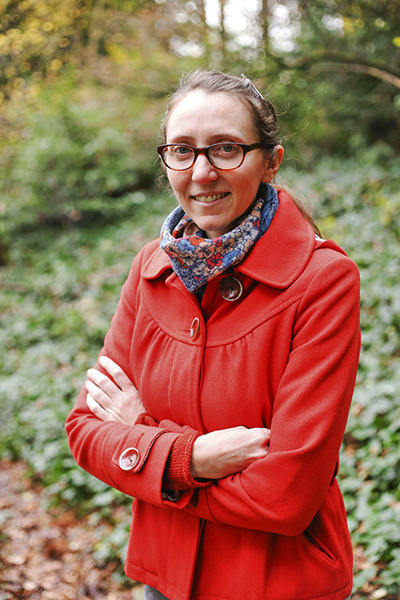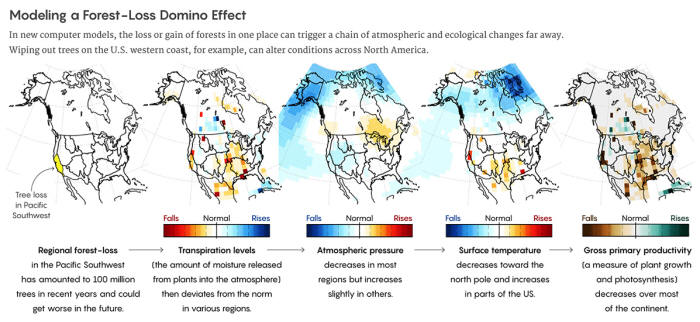|
by Gabriel Popkin from QuantaMagazine Website
Forests routinely transfer extraordinary amounts of water vapor into the atmosphere - the equivalent of "flying rivers" - and scientists are only beginning to understand the complex consequences
for
rainfall and climate at remote locations.
New work at the intersection of atmospheric science and ecology is finding that forests can influence
rainfall and
climate from across a continent...
For decades, most
atmospheric scientists had focused their weather and climate models
on wind, rain and other physical phenomena.
The destruction or
expansion of forests on one continent might boost rainfall or cause
a drought halfway around the world.
Their results could shake up climate science.
And, she added,
The government had embraced a dubious theory pushed by land speculators and rejected the counsel of one of the nation's top scientists, John Wesley Powell.
Spurred on by such optimistic but dubious claims, thousands of would-be farmers headed west, only to find that greening the land did not, in fact, make it rain.
Many struggled to scrape
a living from the dry ground, and the ill-conceived agricultural
experiment eventually contributed to the devastating Dust Bowl.
can move water on almost inconceivably
large scales.
Early meteorologists, hoping to save their young field's credibility, rejected the notion that forests influence weather.
Plants were relegated to
passive participant status.
They pump water from the ground through their tissues to the air, and they move carbon in the opposite direction, from air to tissue to ground.
All the while, leaves
split water, harvest and manipulate solar energy, and stitch
together hydrogen, oxygen and carbon to produce sugars and starches
- the sources of virtually all food for Earth's life.
Stomata are essentially microscopic mouths that simultaneously take in carbon dioxide from the air and let out water.
As Swann notes, the gas exchange from each stoma - and indeed from each leaf - is, on its own, tiny. But with billions of stomata acting in concert, a single tree can evaporate hundreds of liters of water per day - enough to fill several bathtubs.
The world's major forests, which contain hundreds of billions of trees, can move water on almost inconceivably large scales.
Antonio Nobre, a climate scientist at Brazil's National Institute for Space Research, has estimated, for example, that the Amazon rainforest discharges around 20 trillion liters of water per day - roughly 17 percent more than even the mighty Amazon River.
shows the mouth-shaped stomata, or regulated pores, that plants open and close to control the amount of water vapor they release into the air. A single tree can release the equivalent
of
hundreds of liters of water in a day.
Scientists have known since the late 1970s that the Amazon rainforest - the world's largest, at 5.5 million square kilometers - makes its own storms.
More recent research reveals that half or more of the rainfall over continental interiors comes from plants cycling water from soil into the atmosphere, where powerful wind currents can transport it to distant places.
Agricultural regions as diverse as the U.S. Midwest, the Nile Valley and India, as well as major cities such as Sao Paulo, get much of their rain from these forest-driven "flying rivers."
It's not an exaggeration
to say that a large fraction of humanity's diet is owing, at least
in part, to forest-driven rainfall.
Normally we might assume that,
But maybe that's all backward.
In the 1980s, Fung had helped pave the way for climate models that included realistic vegetation and associated carbon dioxide fluxes.
(Among her other accomplishments, she was a co-author on the 1988 paper - Global climate changes as forecast by Goddard Institute for Space Studies three-dimensional model - with the NASA scientist James Hansen that helped bring climate change to the public's attention.)
The model she worked with
was state-of-the-art at the time, but, like its counterparts at
other research institutions, it could only represent the biosphere
simplistically.
Fung suggested that Swann try foresting the Arctic in a climate model. Trees are colonizing higher latitudes as the globe warms, so it seemed reasonable to ask what impact they would have on the region's climate.
Other researchers had previously looked into the potential effects of an expansion of northern spruce forests; unsurprisingly, they found that the Arctic would likely get warmer because those trees' leaves are dark and would absorb more sunlight than virtually any of the tundra, ice and shrubs they might replace.
Swann decided to look
into what would happen if the encroaching forests were deciduous
trees with lighter colored leaves, such as birch or aspen.
Swann determined that her simulated forests emitted a lot of water vapor, which, like carbon dioxide, is a greenhouse gas that absorbs infrared radiation from Earth and redirects some of it downward.
The vapor then caused ice to melt on land and at sea, exposing darker surfaces that absorbed yet more sunlight and grew even warmer. The new forests had set off a feedback loop, amplifying the impact of climate change.
The finding hinted at the power that plants could exert over a region's climate.
who heads the Ecoclimate lab at the University of Washington, is at the vanguard of scientists studying how plants can exert an unexpectedly great influence
on
weather patterns.
Again, this exercise exaggerated something already happening in the real world:
As in the Arctic study, the new trees absorbed sunlight and warmed, adding energy to the climate system.
Atmospheric currents then redistributed this energy around the planet. Droughts descended on the southern Amazon and rain fell in the Sahara.
These effects were caused by a repositioning of the Hadley cell - the massive conveyor belt of air that rises from the equator, dumps its rain over the tropics, and descends again as dry air at around 30 degrees north and south latitudes, where most of the world's deserts are.
Through the influence of
plants alone, the Hadley cell had shifted to the north.
Fung wasn't that surprised:
In periodic El Niño events, which have been understood since the 1920s, unusually warm surface water in the eastern Pacific Ocean triggers heavy rain in western South America and Africa and droughts in Southeast Asia and Australia.
The novelty in Swann's simulated events was that forests, not oceans, did the influencing.
A recent study in Nature
(Global
land change from 1982 to 2016)
reported that in the last three and a half decades, tree cover has
increased by more than 2 million square kilometers in these regions.
Since 2010, nearly 130
million trees have died in California alone, mostly because of
drought and wildfire.
in the Pacific Southwest, forests in the Midwest and eastern U.S.
suffered...
Based on severe droughts that occurred in 2005, 2010 and 2015, some scientists believe the Amazon may be nearing a tipping point that would cause much of its rainforest to turn to savanna, with potentially devastating consequences for carbon storage, biodiversity and local climate.
A paper from late 2017 provided evidence that future warming would make droughts even more lethal to the forests of the American Southwest (Temperature response surfaces for mortality risk of tree species with future drought).
Some scientists predict
that many of the Southwest's forests could become savanna or
grasslands, and at least one -
Nate McDowell at Los Alamos
National Laboratory - has been quoted as
saying that a large
fraction of the region's trees could die.
Swann's and Fung's research suggested that plants need to be brought to the fore.
And other researchers have taken note. Earlier this year, two groups of scientists, both of which included Swann, authored studies of how forest-driven water transport will change as carbon dioxide levels rise.
Studies of individual leaves have shown that when plants are bathed in carbon dioxide, they don't need to make as many stomata per leaf, and they close the ones they do make more of the time.
These changes help forest plants conserve water to survive, but they reduce the water vapor available to fall as rain on the surrounding continent. Moreover, when plants transpire, they cool Earth's surface and warm the air, just as the evaporation of sweat cools your body on a hot day.
Leaf-level changes,
scaled up across continents, could rob the atmosphere of moisture
and warm the planet's surface.
Pritchard said he hadn't previously been aware of the stomatal closure effect.
The knowledge inspired him to join a group led by Gabriel Kooperman, a climate scientist then at UC Irvine, investigating the future effects of enhanced carbon dioxide over the three major tropical forest regions,
if you plant this amount of trees,
you would see
this reduction in planetary warming. National Center for Atmospheric Research
Moreover, the Amazon - home to the world's most carbon-rich and biodiverse rainforest - would get hit with the most severe declines. Swann is now probing the effects of forest changes at different scales.
In
a 2016 paper, she reported that wiping out forests in
western North America made forests in eastern South America grow
more vigorously, while reducing growth in Europe.
The results were dramatic... When she wiped out trees in the Pacific Southwest, forests in the Midwest and eastern U.S. suffered.
In recent years, the Pacific Southwest has, in fact, lost
an estimated 100 million trees, mostly to droughts and voracious
insects.
adapted from Abigail L. S. Swann et al doi:10.1088/1748-9326/aaba0f
In Swann's study, removing trees from the mid-Atlantic actually helped forests elsewhere, by making those regions' summers cooler or wetter.
Swann emphasizes that this does not mean people should cut down forests, which provide innumerable benefits beyond their influence on other regions, including carbon storage, wildlife habitat and water filtration.
But she notes that
environmental groups often plant trees as a climate solution without
considering whether the trees could harm forests elsewhere - or warm
the planet by absorbing solar energy.
No one knows what effects they have had on the global climate.
For Swann, it was a thrill to see any effect.
Douglas Sheil is skeptical of the results of the Kooperman-led study. He thinks climate models do not represent plant biology and the physics of air movement and rainfall accurately enough to say anything meaningful about the real biological world.
He notes, for example, that different climate models given the same input often make different predictions. Others point out that ecoclimate researchers have relied largely on one model, the Community Earth System Model, or CESM.
Typically, climate scientists aren't convinced that a phenomenon is real until they have seen it in the output of numerous models; for instance, the next Intergovernmental Panel on Climate Change report will incorporate results from more than 30 models.
It's possible that the
CESM may be unusually sensitive to vegetation, Pritchard said.
at what a powerful role
plants actually
play. Columbia University
In her recent paper on U.S. forests, for example, there were too many disparate mechanisms to investigate one by one, she said.
The situation is reminiscent of the hypothetical butterfly flapping its wings in Brazil and setting off a tornado in Texas:
Elucidating such mechanisms will be a focus of future work. Addressing these concerns won't happen overnight, however.
Most models, unlike the CESM, can only be run at a modeling center by the handful of scientists who created them. Those people are busy running simulations for the next Intergovernmental Panel on Climate Change report, due out in 2022.
None of the models being
used fully account for plants' influence on climate, Swann said.
Clouds cool the planet by
reflecting incoming sunlight, but they also warm the planet because
they are made of water vapor, a greenhouse gas. Models differ wildly
on how much clouds will contribute to cooling and warming in the
future, and thus whether a doubling of atmospheric carbon dioxide
will be problematic but manageable, or catastrophic.
And Swann and Fung's
results open up at least the possibility that plants could have as
much effect as cloud physics on nailing down the answers to such
questions.
Swann admits, however, that she's,
She and David
Breshears, an ecologist at the University of Arizona and one of
her co-authors on the U.S. forest paper (Continental-scale
consequences of tree die-offs in North America - Identifying where
forest loss matters most), are also exploring how
future southwestern forest losses will affect the climate of the
Midwest, the nation's breadbasket and one of the most productive
agricultural areas on Earth.
In just over a decade, ecoclimate teleconnections have gone from being virtually unknown to appearing as a frequent discussion topic at major scientific meetings such as the Ecological Society of America and the American Geophysical Union.
No longer are such ideas dismissed as not being,
The developments in this new research area demonstrate that future climate scientists will need to master two fields that have, for more than a century, been largely separate, Fung said:
|





